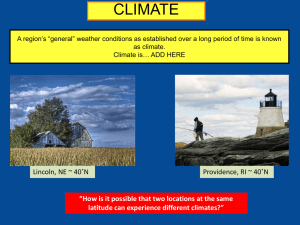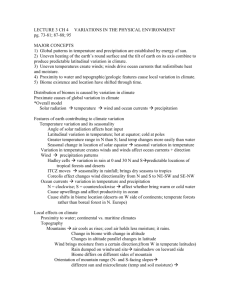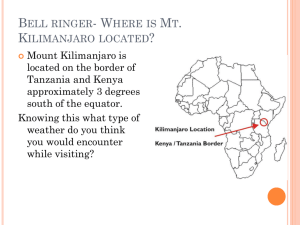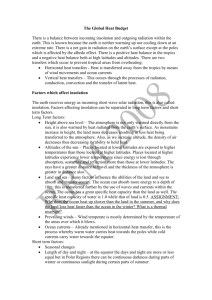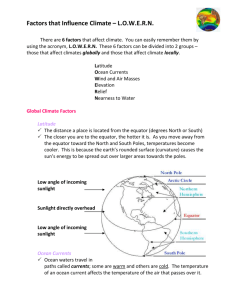Climate A region*s *general* weather conditions as established
advertisement
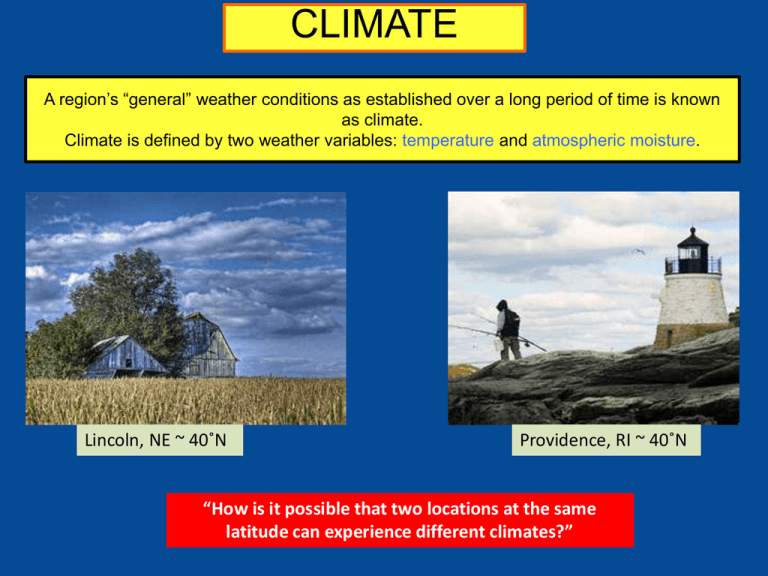
CLIMATE A region’s “general” weather conditions as established over a long period of time is known as climate. Climate is defined by two weather variables: temperature and atmospheric moisture. Lincoln, NE ~ 40˚N Providence, RI ~ 40˚N “How is it possible that two locations at the same latitude can experience different climates?” Climate Regions SUB-HUMID SEMI-ARID P ≅ PET HUMID P > PET P = Annual Precipitation (moisture) PET = Potential Evapotranspiration (temperature) ARID P < PET Latitude Planetary Winds and Pressure Belts Vegetatio n Factors Affecting Climate Large Bodies of Water Cloud Cover Elevatio n Ocean Currents Mountains Climate Change due to Latitude The Earth receives maximum intensity and fairly consistent duration of insolation between 23 ½ ˚N and 23 ½ ˚S during its revolution around the Sun. Annual temperatures tend to be high and there is a minimal variation in temperature throughout the year. Latitudes north of 23 ½ ˚N and latitudes south of 23 ½ ˚S never receive direct insolation and the duration of insolation fluctuates. Annual temperatures tend to vary over a wide range seasonally. Climate Change due to Latitude Low High The location of pressure belts will alter the moisture conditions at certain latitudes. Low pressure belts (convergence) are known for rising air, cloud development and precipitation. Humid-like climate Low High Low High pressure belts (divergence) are known for descending air, few clouds and lack of precipitation. Arid-like climate Climate Change due to Large Bodies of Water Land tends to heat up and cool down more quickly than water (due to specific heat). The temperature of a location near a large body of water will be moderated by its presence near the water (MARINE CLIMATE) The temperatures of locations far away from large bodies of water are not affected by the presence of water (CONTINENTAL CLIMATE). Lincoln, NE (CONTINENTAL CLIMATE) Providence, RI (MARINE CLIMATE) There is no large body of water nearby to moderate the temperature of the city. The Atlantic Ocean helps to moderate the temperature of the city. Hot summers and Cold winters. Cooler summers and warmer winters. A wide annual temperature range. A narrow annual temperature range. Climate Change due to Prevailing Winds Prevailing winds are generated by the convergence/divergence of air near pressure belts and due to the Coriolis Effect. Storm track moving westward pick up moisture over the Great Lakes. Cities in northwestern New York experience “lake effect” snows and rains due to this movement (more humid climate). Southern California is much “more of a marine climate” (more moderate climate )due to the southwesterly winds blowing off the Pacific Ocean. Climate Change due to Ocean Currents Surface ocean temperatures are a reflection of the amount of insolation received. Warm ocean currents tend to move away from the equator. Warm ocean currents create warm, humid conditions for coastal locations. Cool ocean currents tend to move towards the equator. Cool ocean currents create cool, drier conditions for coastal locations. RT = Pg. 4 Some parts of Europe (Ireland, Iceland, England) may be more humid and a bit warmer during certain times of the year due to their presence near warm ocean currents. The location and pathway of ocean currents will change as the amount of insolation received by certain parts of the oceans changes during Earth’s revolution. As air rises it expands and cools. Higher elevations are less likely to be affected by greenhouse gases and the infrared radiation being absorbed by them. Air Temperature Climate Change due to Elevation As air rises its temperature drops as does its capacity to hold water vapor. Dewpoint temperature is reached, clouds form and precipitation follows. Chance of Precipitation Elevation Elevation Generally speaking….. Climate Change due to Mountains “The Orographic Effect” LEEWARD WINDWARD Cool and humid Warm and arid As prevailing winds move down the mountain: As prevailing winds move up the mountain: 1. Air rises, expands, and cools. 2. Dewpoint is reached; clouds form due to condensation. 3. Precipitation occurs. 1. 2. 3. Air descends, compresses, and warms. Air temperature is too high for dewpoint to be reached. Little to no precipitation occurs. Climate Change due to Vegetation The vegetation of a region is determined by its climate. When the vegetation of a region is removed, the climate will change. The destruction of this forest will cause the climate to change: 1. 2. 3. 4. More insolation reaches the soil Temperatures rise Increase in greenhouse gases Less infiltration of water into the soil Deforestation Arid Humid Urbanization Climate Change due to Cloud Cover Ecuadorian Beach, South America ~ 0˚ latitude (equator) Areas that are prone to cloudy skies often experience climatic change: 1. Less insolation strikes the earth’s surface. 2. Slight drop in temperature. 3. Clouds absorb and reflect insolation back into space. The equator is NOT the warmest spot on Earth due to the uplift of air from the low pressure belt. This will lead to cloud formation and precipitation. “How come the equator is NOT the warmest spot on Earth’s surface? Where is the warmest place?” The warmest place on Earth would be at the high pressure belts (30˚ N and S) where air is descending and there is a lack of clouds.

